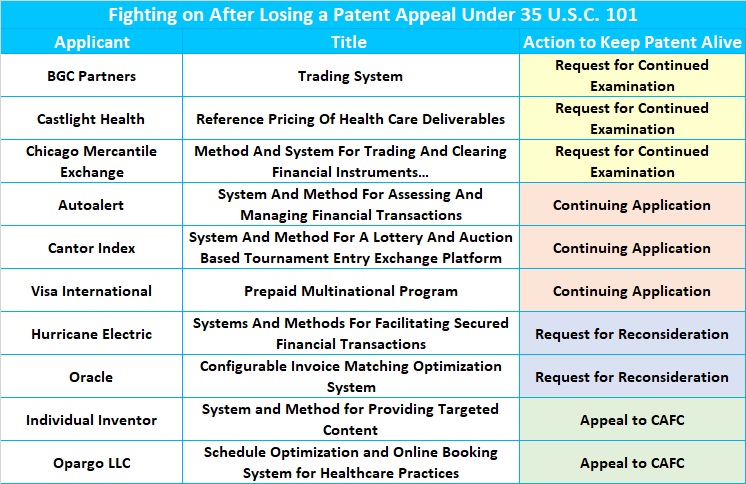“The 2019 Guidance has increased the chance of prevailing on appeal, but the loss rate is still 80%.”
As we enter Alice’s birthday week, Mark Nowotarski offers a cautious ray of hope for business method applications.
 It’s tough to fight on after losing an Alice appeal, but that’s just what most applicants are doing. An “Alice appeal” is an appeal of a patent rejection under 35 U.S.C. 101 for lack of statutory subject matter. The major field of these patents is business methods (class 705). More than half of business method applicants that are losing Alice appeals are taking action to keep their applications alive. The reasons for renewed hopes include the new 2019 Subject Matter Eligibility Guidance that came out in January, as well as the current movement in Congress to clarify 35 U.S.C. 101. With hope on the horizon, now is not the time to give up.
It’s tough to fight on after losing an Alice appeal, but that’s just what most applicants are doing. An “Alice appeal” is an appeal of a patent rejection under 35 U.S.C. 101 for lack of statutory subject matter. The major field of these patents is business methods (class 705). More than half of business method applicants that are losing Alice appeals are taking action to keep their applications alive. The reasons for renewed hopes include the new 2019 Subject Matter Eligibility Guidance that came out in January, as well as the current movement in Congress to clarify 35 U.S.C. 101. With hope on the horizon, now is not the time to give up.
The table below gives some recent examples of how both large and small applicants are continuing to prosecute their patent applications after losing an Alice appeal.

Take Action
If you’ve just lost an Alice appeal, the four actions you can take are:
- File a Request for Continued Examination (RCE): You and your attorney or agent can amend your claims in light of the 2019 Guidance. The claims then go back to the patent examiner for more examination. About half of the requests for continued examination filed in the past 18 months have been successful in getting claims allowed.
- File a Continuing Application: You can refile your application with entirely new claims. This is called a continuing application. If the claims are directed to a different invention described in your patent application, there’s about a 50% chance your application will be assigned to another examiner and/or another art unit. This can increase your chances of getting a case allowed if your current examiner is particularly difficult to reach agreement with.
- File a Request for Reconsideration: If there are errors in the Patent Trial and Appeal Board’s decision, you can point them out to the Board and ask them to reconsider the decision. I was initially skeptical of this approach, but in some cases, like the Oracle example above, applicants are succeeding. This option may also be the fastest way to success.
- File an appeal with the Court of Appeals for the Federal Circuit (CAFC): At the other end of the spectrum is filing an appeal of the Board’s decision to the Court of Appeals for the Federal Circuit. There were more of these than I expected (I honestly didn’t expect any), including one example of an independent inventor filing an appeal.
You only have 63 days to take action after losing an appeal or your application will go abandoned. If you have a pending appeal, it might make sense to consult now with your patent attorney or agent to determine what action would be best should you lose your appeal. The 2019 Guidance has increased the chance of prevailing on appeal, but the loss rate is still 80%.
Know Your Examiner
An important consideration in determining how to best proceed is to determine how your particular examiner has responded to the 2019 Guidance. As we reported last month in “Business Method Patents Recover Under USPTO Guidance”, overall allowance rates are up in business methods. Most examiners now have a broader view on what qualifies as statutory subject matter. If you review what your examiner has allowed since the new guidance came out, that may point the way to claim amendments that will be successful should you decide to file an RCE.
Not all examiners, however, have responded with equal enthusiasm to the new guidance. If you have one of the more reluctant examiners, then that may point you towards the option of filing a continuing application. You even have the option of adding more technical content to your patent application if that is lacking in your original filing. The more technical content, the better. Redrafting with new technical content, however, without sacrificing your original filing date, is quite tricky. Nonetheless, several patent agents and attorneys I have spoken with have found this approach to be quite effective.
There are many options available to an applicant after losing an Alice appeal. Talk to your patent attorney or agent about what the best options might be for you. If your invention is important, you can still fight on.

![[IPWatchdog Logo]](https://ipwatchdog.com/wp-content/themes/IPWatchdog%20-%202023/assets/images/temp/logo-small@2x.png)

![[Advertisement]](https://ipwatchdog.com/wp-content/uploads/2024/04/Patent-Litigation-Masters-2024-sidebar-early-bird-ends-Apr-21-last-chance-700x500-1.jpg)

![[Advertisement]](https://ipwatchdog.com/wp-content/uploads/2021/12/WEBINAR-336-x-280-px.png)
![[Advertisement]](https://ipwatchdog.com/wp-content/uploads/2021/12/2021-Patent-Practice-on-Demand-recorded-Feb-2021-336-x-280.jpg)
![[Advertisement]](https://ipwatchdog.com/wp-content/uploads/2021/12/Ad-4-The-Invent-Patent-System™.png)







Join the Discussion
6 comments so far.
Anon
June 17, 2019 04:41 pmI had the same reaction as mike @ 4.
This is not a semantic difference and no amount of “fleshing out” is permitted to add new matter. In this sense, the phrase “redrafting with new technical content” is simply not the phrase to be used.
Further, “fleshing out” that does not add new matter may be better phrased as simply rephrasing what is quite evidently already there. Caution should be applied in any attempt to “get away with” anything that is not quite evidently already there because it must be remembered that obtaining the buy-in of the examiner is often NOT the end-goal in the game. Having a property that can be enforced IS often the end-goal (with of course a provisio that some clients actually only want to build a war chest, and having numbers then may well be the end-goal).
Mark Nowotarski
June 17, 2019 01:19 pmmike@4
It really depends upon whether you are fleshing out technical content that was already there or adding genuinely new content. If you are fleshing out what is already there, you may be able to preserve your priority date.
mike
June 17, 2019 12:07 pm“Redrafting with new technical content, however, without sacrificing your original filing date, is quite tricky. Nonetheless, several patent agents and attorneys I have spoken with have found this approach to be quite effective.”
How might one do this without losing priority benefit?
B
June 17, 2019 10:56 amMark, I respect you and value your insight. All that said, the USPTO and courts are free fabricate and break whatever law they choose with zero risk of being called out for their misbehavior.
Night Writer
June 17, 2019 10:45 amInteresting. Some of our clients are doing this too. It will, of course, only last so long before the clients start to give up. We are still in the phase of the clients having lived through plenty of nonsense from the courts, CAFC, Congress, and the Scotus that they are willing to keep spending money for a while longer.
Concerned
June 17, 2019 09:30 amClass 705, s101 rejection and in appeal.
Frustrating that my rejection was not factual or truthful on the surface.
Claims cannot be routine, well understood or conventional if nobody on Earth has ever performed even one of the my claims, and certainly not performed in combination. The examiner even refused to rebut the evidence which proved my point.
The examiner also admitted in writing that the rejection was not based on the same subject matter, only similar case law way outside my field of technology. There is a reason that experts and working professionals in my field have been unable to solve the problem since 1956 until my solution and it was not because the solution was routine, conventional and well understood.
My rejection was dead on arrival forcing the courts to do the USPTO’s job.
Disclaimer: I think my examiner had marching orders from above.